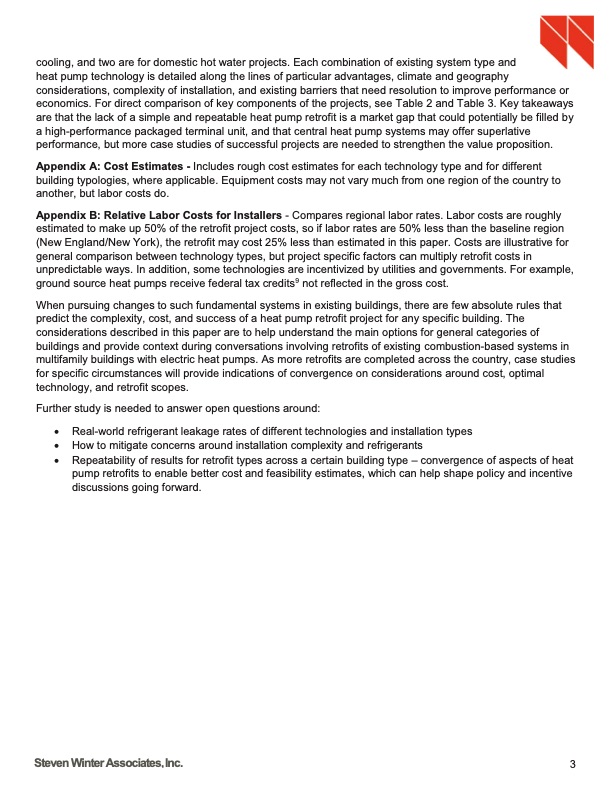
PDF Publication Title:
Text from PDF Page: 003
cooling, and two are for domestic hot water projects. Each combination of existing system type and heat pump technology is detailed along the lines of particular advantages, climate and geography considerations, complexity of installation, and existing barriers that need resolution to improve performance or economics. For direct comparison of key components of the projects, see Table 2 and Table 3. Key takeaways are that the lack of a simple and repeatable heat pump retrofit is a market gap that could potentially be filled by a high-performance packaged terminal unit, and that central heat pump systems may offer superlative performance, but more case studies of successful projects are needed to strengthen the value proposition. Appendix A: Cost Estimates - Includes rough cost estimates for each technology type and for different building typologies, where applicable. Equipment costs may not vary much from one region of the country to another, but labor costs do. Appendix B: Relative Labor Costs for Installers - Compares regional labor rates. Labor costs are roughly estimated to make up 50% of the retrofit project costs, so if labor rates are 50% less than the baseline region (New England/New York), the retrofit may cost 25% less than estimated in this paper. Costs are illustrative for general comparison between technology types, but project specific factors can multiply retrofit costs in unpredictable ways. In addition, some technologies are incentivized by utilities and governments. For example, ground source heat pumps receive federal tax credits9 not reflected in the gross cost. When pursuing changes to such fundamental systems in existing buildings, there are few absolute rules that predict the complexity, cost, and success of a heat pump retrofit project for any specific building. The considerations described in this paper are to help understand the main options for general categories of buildings and provide context during conversations involving retrofits of existing combustion-based systems in multifamily buildings with electric heat pumps. As more retrofits are completed across the country, case studies for specific circumstances will provide indications of convergence on considerations around cost, optimal technology, and retrofit scopes. Further study is needed to answer open questions around: � Real-world refrigerant leakage rates of different technologies and installation types � How to mitigate concerns around installation complexity and refrigerants � Repeatability of results for retrofit types across a certain building type – convergence of aspects of heat pump retrofits to enable better cost and feasibility estimates, which can help shape policy and incentive discussions going forward. Steven Winter Associates,Inc. 3PDF Image | HEAT PUMP RETROFIT STRATEGIES FOR MULTIFAMILY BUILDINGS

PDF Search Title:
HEAT PUMP RETROFIT STRATEGIES FOR MULTIFAMILY BUILDINGSOriginal File Name Searched:
heat-pump-retrofit-strategies-report-05082019.pdfDIY PDF Search: Google It | Yahoo | Bing
CO2 Organic Rankine Cycle Experimenter Platform The supercritical CO2 phase change system is both a heat pump and organic rankine cycle which can be used for those purposes and as a supercritical extractor for advanced subcritical and supercritical extraction technology. Uses include producing nanoparticles, precious metal CO2 extraction, lithium battery recycling, and other applications... More Info
Heat Pumps CO2 ORC Heat Pump System Platform More Info
| CONTACT TEL: 608-238-6001 Email: greg@infinityturbine.com | RSS | AMP |